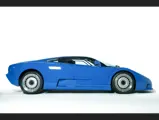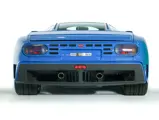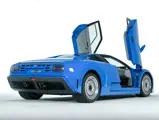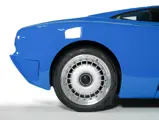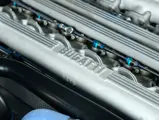Amelia Island 2022
1994 Bugatti EB110 GT Prototype
{{lr.item.text}}
$2,100,000 USD | Sold
 | Amelia Island, Florida
| Amelia Island, Florida
{{internetCurrentBid}}
{{internetTimeLeft}}

- Extremely rare prototype used by the factory for promotional and exhibition purposes
- Minimally used example displaying near-showroom quality
- Exhibited at numerous auto shows, including the 1992 Bologna Motor Show
- Unique one-off features in interior and bodywork
- Driven only 1,095 km (~681 miles) at cataloguing
- Groundbreaking technical profile including quad-turbocharged V-12 engine and all-wheel drive
- Model that set four speed records, including world’s fastest production car
- Important component of Bugatti brand history
To bring a long-dormant automotive marque back to life is no mean feat; the stakes are even higher when the marque in question is one as hallowed as Bugatti. In the late 1980s, however, Italian entrepreneur Romano Artioli rose to the challenge, and while his dream was relatively short-lived, the vehicles he brought to fruition—the Bugatti EB110 GT and its evolution, the EB110 Super Sport—are truly regarded to have done justice to the legendary nameplate.
After several years of relentless development, and anticipating production success, Artioli went so far as to commission a stylish modern factory for the reborn automaker, the scale of which testified to his ambition. Although Artioli’s iteration of Bugatti was located in the high-performance hotspot that is Modena, Italy, rather than Bugatti’s original (and current) Alsatian home in Molsheim, France, one suspects that Ettore Bugatti himself would have appreciated the scale and grandeur of the impressive, architecturally imposing facility.
Yet the cars produced at that facility were even more impressive. Named in honor of Ettore Bugatti’s 110th birthday, the EB110 model was the first of a planned range of offerings, and it was built on a chassis originally conceived in aluminum by the great Paolo Stanzani, and later reimagined in carbon fiber by Nicola Materazzi, chief engineer of the Ferrari F40. Carbon fiber has since become de rigueur in modern supercars, and it is notable that construction of the groundbreaking frame was contracted to the French aerospace concern Aérospatiale. The advanced composite material was selected because the originally planned aluminum honeycomb was found to be too flexible for an ultra-high-performance mid-engine machine. This chassis was wrapped in striking bodywork that, in production form, combined elements of a concept design by celebrated stylist Marcello Gandini, with refinements by Giampaolo Benedini (an architect related to Artioli).
For power, the EB110 GT was equipped with a distinctive 3.5-liter quad-turbocharged V-12 mated to a six-speed manual transmission. A finely tuned all-wheel drive system, yet another forward-looking piece of supercar technology, helped tame the V-12’s 553 horsepower while ensuring that the EB110 would be as tractable as it was trackable.
As with most such modern supercar models, the EB110 GT evolved through a careful series of prototypes that underwent two distinct phases. From 1990 through 1991 several aluminum-chassis prototypes were built and clothed with Gandini’s original coachwork design, and these cars were assigned chassis numbers with an “A” prefix, the A standing for aluminum.
In 1991 Materazzi and Benedini conducted a technical and aesthetic evaluation of the original car and built a small batch of secondary prototypes through late 1992, with C-prefix chassis numbers (the C standing for carbon fiber). Many of these cars were driven hard during developmental testing, and several others were destroyed during safety crash-testing, leaving very few prototypes in such outstanding condition as the featured lot.
Chassis number 39012 is one of a small handful of second-series prototypes to have experienced so little driving use. Believed by many in the EB110 GT community to be perhaps the least used of the prototypes, this rare car is equipped with several one-off features (including interior pieces and the rear grille), and it boasts the further distinction of being one of very few cars used for official factory exhibition and promotional events.
According to the records of the online EB110 Registry, chassis number 39012 was completed during 1992 as a carbon fiber developmental prototype, built on Aérospatiale frame number 12, and finished in dark green metallic paint with a grey leather interior. Unlike most such prototypes, the Bugatti experienced very little drive-testing use, and on the contrary became a demonstration and exhibition car.
Among other appearances, the prototype was presented at the Bologna Motor Show in December 1992, and it was also showcased in a promotional display at the Grosvenor House Hotel in London in February 1993. In 1994, 39012’s coachwork was refinished by the factory in Bugatti Blue for further exhibition opportunities over the following two years, and it was later chosen for emissions testing requirements to satisfy Swiss and American regulations. In preparation for this the car was modified with revisions to the engine, fuel injectors, exhaust system, and the fuel tanks.
Two years later, when Bugatti Automobili SpA became insolvent, the company’s assets passed to outside ownership, including several cars—among them was 39012. Registered in Italy as AM 389 LA, the prototype was eventually refreshed with a refurbished spare motor, and the interior was reupholstered in light grey, with complementary-colored trim parts. Minor panel adjustment was conducted to match later-production examples, including installation of a Super Sport-specification rear grille, and a new set of wheels was mounted. The restoration was then reportedly detailed in a feature article in the April 2001 issue of a German automotive magazine.
After being offered for sale in Switzerland, the EB110 GT is said to have sold to the next private owner in 2000. He kept the car for over 12 years, along the way exhibiting it at the Monaco Motor Museum in late 2012. The Bugatti was advertised in The Netherlands a year later, and in 2014 it was serviced in Germany. In 2015 the unique prototype was sold to a respected American collector based in Chicago, Illinois, and more recently the car has benefited from a reported round of service, suggesting excellent current mechanical condition.
The unique EB110 GT continues to display outstanding quality, with the odometer showing just 1,095 kilometers (~680 miles) at time of cataloguing, and it is very likely the finest prototype example in existence. It should encounter a warm welcome at supercars gatherings and marque focused events, sure to stoke the passion of any supercar enthusiast. Also appropriate for museum exhibition, and serviced for proper driving enjoyment, this important Bugatti is very likely the most exceptional EB110 prototype to be found, replete with the essence of Le Pur Sang.





